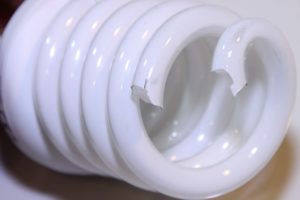
I Broke a CFL. Now What?
Compact fluorescent light bulbs (CFLs) use 75% less energy than traditional incandescent bulbs and last about six times longer, but it’s no secret that CFLs contain a small amount of mercury (about 4 milligrams per bulb on average).
Like any glass product, CFLs tend to break occasionally, causing many homeowners to worry about potential mercury exposure and adverse health effects. So, just how dangerous is a broken CFL? Should you dig out the gas mask and Hazmat suit?
Earth911 sat down with John Rogers, a senior energy analyst for the Union of Concerned Scientists who specializes in clean energy, to get to the bottom of these pressing questions about CFL safety, cleanup, and disposal.
Oops … I Broke a CFL!
When CFLs first came out, there was a lot of news coverage about mercury in CFLs, so an initial freak-out moment after breaking a bulb is understandable. But clean energy expert John Rogers helped ease our minds. “This is a manageable problem,” he assured us. “Most of the time they don’t break. If they do break, there are procedures we follow.”
Any level of mercury exposure carries potential health concerns, but due to the small amount of mercury and short duration of exposure, a broken CFL is not likely to present a significant risk to you or your family, Rogers told Earth911.

“You’re talking under 5 milligrams of mercury,” he said. “That figure won’t mean much to people, so to put it in perspective: if you think about the mercury thermometers that I grew up with, it’s less than 1% of the amount of mercury that was in one of those thermometers.”
Make note of the following cleanup steps in case you ever break a CFL bulb. Find the EPA’s detailed instructions here.
1. Before Cleanup
- Have people and pets leave the room.
- Air out the room for five to 10 minutes by opening a window or door.
- Shut off the forced-air heating and cooling system, if you have one.
- Collect the following materials to clean up the broken bulb: Stiff paper or cardboard, sticky tape, damp paper towels or disposable wet wipes (for hard surfaces), and an airtight container, such as a glass jar with a metal lid or a resealable plastic bag.
2. During Cleanup
- Do not vacuum. Vacuuming is not recommended unless broken glass remains after all other cleanup steps have been taken, as doing so may spread mercury-containing powder or mercury vapor.
- Thoroughly scoop up glass fragments and powder using stiff paper or cardboard. Use sticky tape, such as duct tape, to pick up any remaining small glass fragments and powder.
- Place the used tape in the glass jar or plastic bag. See detailed cleanup instructions from the EPA for more information, and for differences in cleaning up hard surfaces versus carpeting or rugs.
- Place cleanup materials in a sealable container.
3. After Cleanup
- Promptly place all bulb debris and cleanup materials, including any vacuum cleaner bags used, outdoors in a trash container or protected area until materials can be disposed of. Avoid leaving any bulb fragments or cleanup materials indoors.
- Use Earth911 to track down a recycling solution near you. CFLs are household hazardous waste and should not be disposed of with your regular garbage.
- If weather and other conditions allow, continue to air out the room where the bulb was broken and leave the heating and air conditioning system shut off for several hours (a study conducted by the journal Science of The Total Environment found that the critical exposure period passes after four hours).
The Importance of CFL Recycling
Due to mercury content, it’s very important to dispose of CFLs properly. Whether they’re broken or not, they are hazardous waste and shouldn’t go in your regular waste bin. Some states actually ban the disposal of CFLs and other mercury-containing light bulbs in landfills. Luckily, CFL recycling is readily available in most communities through retailer take-back programs and local household hazardous waste (HHW) collection.
Use Earth911 Recycling Search to find a recycling solution in your ZIP code, and use caution when removing and recycling a burnt-out CFL.
The best solution is that we use [CFLs] until the end of their life and then dispose of them in ways to capture that mercury,” John Rogers said. “Part of what we need to do is educate people better about the importance of recycling. That’s an easy thing we can do to keep the mercury down to, essentially, zero.”
When it’s time to replace your old CFLs, increase your energy savings and reduce your environmental impact by choosing energy-efficient LED bulbs.
Originally published on January 11, 2013, this article was updated in January 2023.
Pin this for later!
 Join Our Telegram Group
Join Our Telegram Group